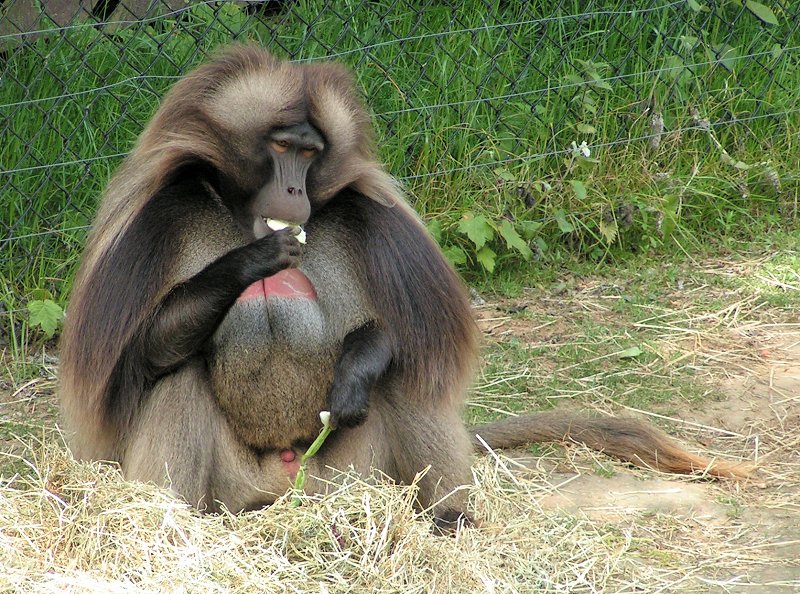- Gelada
Taxobox
name = GeladaMSW3 Groves|pages=167]
status = LC
status_system = iucn3.1
status_ref = IUCN2006 | assessors = Primate Specialist Group | year = 1996 | title = Theropithecus gelada | id = 21744 | downloaded =2006-05-11 ]
trend = unknown

image_width = 250px
image_caption = A male Gelada
regnum =Animal ia
phylum =Chordata
classis =Mammal ia
ordo =Primate s
familia =Cercopithecidae
genus = "Theropithecus"
genus_authority = I. Geoffroy, 1843
species = "T. gelada"
binomial = "Theropithecus gelada"
binomial_authority = (Rüppell, 1835)The Gelada ("Theropithecus gelada"), sometimes called the Gelada Baboon, is a
species ofOld World monkey found only in theEthiopian Highlands , with largepopulation s in theSemien Mountains . "Theropithecus" is derived from the Greek root words for "beast-ape ." [cite web |url=http://www.phthiraptera.org/Classical%20Roots/classical_P.html |title=Classic Roots P |accessdate=2006-12-26 |format=HTML |work=PHTHIRAPTERA CENTRAL |quote=thero (G) - A wild beast; summer; hunt for ] [cite web |url=http://www.phthiraptera.org/Classical%20Roots/classical_T.html |title=Classic Roots T |accessdate=2006-12-26 |format=HTML |work=PHTHIRAPTERA CENTRAL |quote=pithec, -o, -us (G) - An ape ] Like its close relatives thebaboon s (genus "Papio "), it is largely terrestrial, spending much of its time foraging ingrassland s. Since1979 it has been customary to place the Gelada in its own particulargenus ("Theropithecus"), though some genetic research suggests that thismonkey should, in fact, be grouped with itspapio nine kin;cite journal | author = Goodman, M., "et al." | year = 1998 | title = Toward a phylogenetic classification of Primates based on DNA evidence complemented by fossil evidence | journal = Molecular Phylogenetics and Evolution | volume = 9 | pages = 585–598 | doi = 10.1006/mpev.1998.0495] other researchers have classified this species even farther distant from "Papio".cite book | author = McKenna, M.C., Bell, S.K. | title = Classification of mammals above the species level | publisher = Columbia University Press | year = 1997 | location = New York | pages = 631 pp] While "Theropithecus gelada" is the only livingspecies of its genus, at least two separate larger species are known from thefossil record: "T. brumpti" and "T. oswaldi", formerly classified under the generic name of "Simopithecus".fact|date = October 2007 "Theropithecus", while restricted at present toEthiopia , is also known from fossil specimens found inAfrica and the Mediterranean intoAsia , includingSouth Africa ,Malawi , theDemocratic Republic of the Congo ,Tanzania ,Uganda ,Kenya ,Ethiopia ,Algeria ,Morocco ,Spain , andIndia .Appearance
"Theropithecus gelada" can be physically distinguished from baboons by the bright patch of skin on its chest. This patch is
hourglass-shaped , and onmale s, bright red and surrounded by white hair. Onfemale s the patch is far less pronounced. However, when inoestrus , the female's patch will brighten, and a "necklace" of fluid-filledblister s forms on the patch. This is thought to be analogous to the swollen buttocks common to most baboons experiencing oestrus. This modification likely came about due to the Gelada's unique mode of feeding - it spends most of its waking hours grazing from an upright sitting position, rump hidden beneath and so unavailable for display. The male Gelada's tail is about as long as the body and densely tufted at the tip; it also has a long and flowing mantle and mane.The Gelada lives in small
harem s consisting of one male, several females, and their offspring. These smaller bands often join together to feed, forming groups of upwards of 350 individual monkeys. At especially good feeding spots, groups in excess of 670 individuals have been observed.Diet
The Gelada is exclusively herbivorous but is specialised as a
grass -eater, consuming every part of theplant (but favouring one part over the others depending uponseason ), from green blades (in the wet season) toseed s torhizome s (in the dry season) to stalks,flower s, andfruit s. It has the mostopposable thumb of any of the catarrhine primates (not includinghuman s), allowing it to pick apart grasses with great dexterity to select the most nourishing meal. It is one of the only true grazing monkeys.cite web | last = Hiller | first = C. | year = 2000 | url = http://animaldiversity.ummz.umich.edu/site/accounts/information/Theropithecus_gelada.html | title = "Theropithecus gelada" (On-line) | accessdate = 2006-12-23 | work = Animal Diversity Web]Endangered
Although not listed as
endangered , only 50,000-60,000 Geladas are known to exist.Hunting andhabitat destruction have forced the Gelada into areas formerly inhabited only by theOlive Baboon , and hybridisation between the two species has been observed.There are two
subspecies of Gelada:
* "Theropithecus gelada gelada"
* Eastern Gelada, "Theropithecus gelada obscurus"References
External links
* ARKive - [http://www.arkive.org/species/GES/mammals/Theropithecus_gelada/ Images of the gelada "(Theropithecus gelada)"]
* [http://pin.primate.wisc.edu/factsheets/entry/gelada_baboon Primate Info Net "Theropithecus gelada" Factsheet]
Wikimedia Foundation. 2010.
